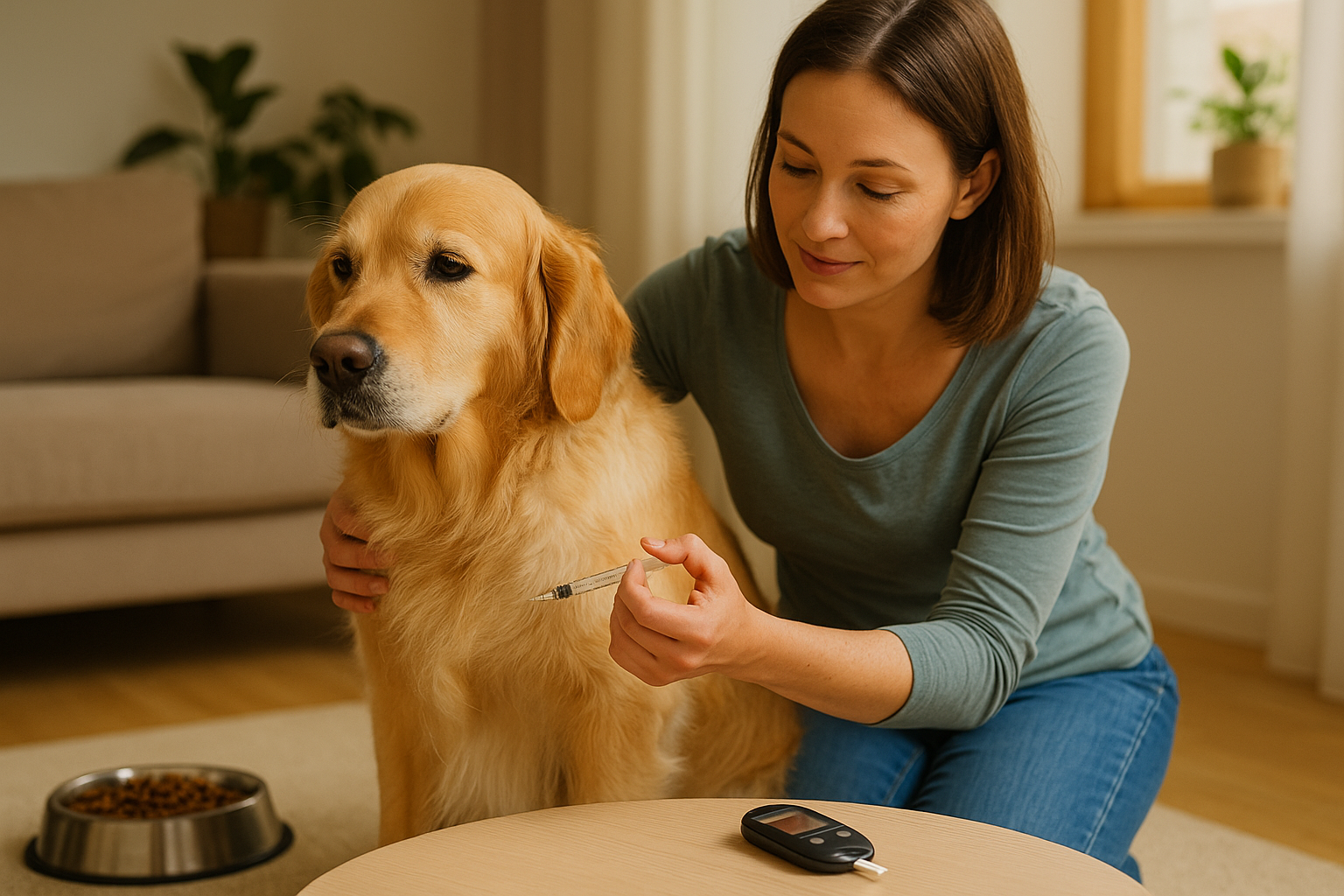Table of Contents
Introduction
Medical Disclaimer: This article is for informational purposes only and does not replace professional veterinary advice. Always consult your veterinarian for medical care.
If your dog has just been diagnosed with diabetes, it can feel overwhelming, but you’re not alone. As a small-animal veterinarian in Canada, I’ve helped many families navigate the daily ups and downs of diabetes in dogs. With the right insulin, a stable diet, and reliable glucose monitoring, dogs with diabetes can live happy, active lives.
In this article, I’ll walk you through everything I share with my clients during those first tough weeks post-diagnosis, what causes diabetes in dogs, which insulin types work best, how to monitor blood sugar at home, and what to feed a diabetic dog. We’ll also cover cost expectations, real-world care tips, and when to call your vet.
Whether your dog was just diagnosed or you’re managing this condition long-term, you’ll find practical, evidence-backed answers here.
Key Takeaways: Diabetes in Dogs
- Diabetes in dogs is typically type 1, requiring lifelong insulin therapy.
- Only two insulins, Vetsulin and ProZinc, are licensed for dogs in Canada; others like NPH or glargine are used off-label.
- Monitoring includes blood glucose curves, at-home glucometers, and continuous glucose monitoring (CGM).
- Diet plays a crucial role: fixed meals, high-fibre diets, and calorie consistency are key.
- With proper care, most diabetic dogs can live normal, happy lives.
- Expect monthly costs of $100–$300+ for insulin, food, and testing supplies.
- Always consult your veterinarian to adjust insulin or manage complications like hypoglycaemia.
What Is Diabetes in Dogs?
Diabetes in dogs is a chronic condition where the body can’t properly regulate blood sugar. Unlike in cats, who more often develop type 2 diabetes, dogs almost exclusively suffer from type 1 diabetes, meaning their pancreas no longer produces insulin at all. This form is irreversible and requires lifelong insulin therapy to survive (Cornell University College of Veterinary Medicine).
Causes and Risk Factors of Diabetes in Dogs
You cam also visit: https://doglifeexpert.com/how-to-treat-chronic-kidney-disease-in-dogs/
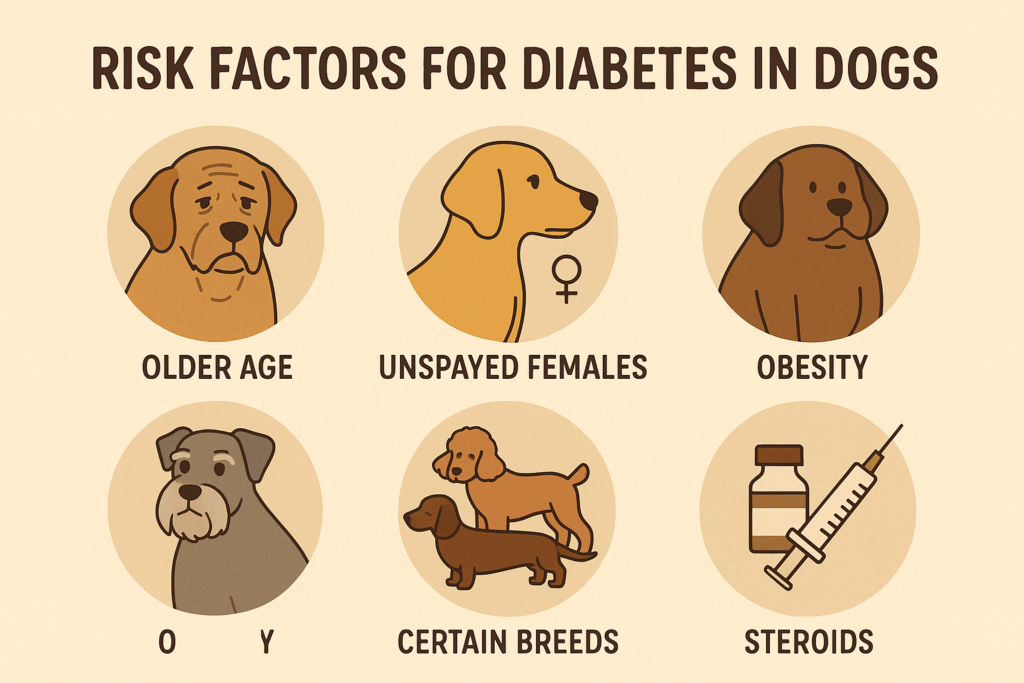
While the exact cause isn’t always clear, diabetes in dogs tends to develop due to a combination of genetics, hormonal factors, and underlying health conditions. It’s most commonly seen in:
- Middle-aged to older dogs (typically age 6 and up)
- Unspayed females
- Breeds genetically predisposed to endocrine disorders, such as Miniature Schnauzers, Poodles, and Dachshunds
- Dogs struggling with obesity or recovering from chronic pancreatitis
- Dogs on long-term corticosteroids or other hormone-altering medications
Emerging research also suggests that some dogs may develop autoimmune reactions that destroy the insulin-producing beta cells in the pancreas, paralleling juvenile-onset diabetes in humans (BioMed Central).
Common Signs of Diabetes in Dogs
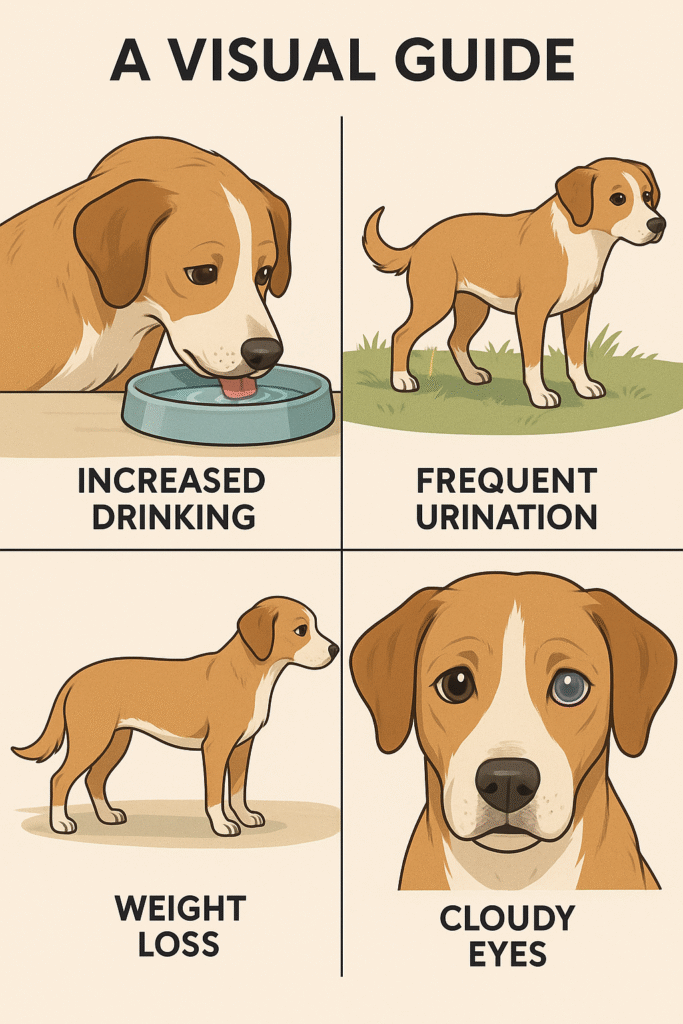
In my practice, most cases of diabetes in dogs are diagnosed after owners report a “sudden change” in their pet’s behaviour or habits. Early signs include:
- Increased thirst (polydipsia)
- Frequent urination (polyuria)
- Unexplained weight loss, even with a good appetite
- Cloudy eyes, which may signal developing cataracts
- Lethargy or less enthusiasm for walks and play
- Recurring urinary tract infections
Too often, I’ve heard pet parents say, “He’s just drinking more water because it’s hot out.” But when we test blood sugar levels, they’re alarmingly high. Recognizing these symptoms early on can dramatically improve treatment outcomes.
How Diabetes in Dogs Is Diagnosed
Veterinarians confirm diabetes in dogs through a combination of blood and urine tests. Hallmarks include:
- Consistently elevated blood glucose (hyperglycaemia)
- Glucose present in the urine (glucosuria)
- Additional tests such as fructosamine or HbA1c (A1CARE) to assess average glucose levels over weeks
An early and accurate diagnosis allows for faster treatment, reducing the risk of dangerous complications like diabetic ketoacidosis (DKA), which can be life-threatening if not caught in time.
Key Insulin Options for Dogs
Managing diabetes in dogs requires daily insulin injections to replace what the pancreas no longer produces. Finding the right insulin type and dose can feel daunting, but with veterinary guidance, most dogs respond well within a few weeks.
Licensed Veterinary Insulins
According to the 2018 AAHA Diabetes Guidelines, there are two insulins approved specifically for dogs:
Vetsulin® (Porcine Lente Insulin)
- Intermediate-acting insulin zinc suspension
- Begins working in 1–2 hours, peaks around 4–8 hours
- Duration: 10–24 hours
- Typical starting dose: 0.25–0.5 U/kg every 12 hours
Vetsulin is often my go-to first choice. It’s FDA- and Health Canada-approved and has a predictable action profile in many canine patients. Some dogs stabilize well on it with minimal dose changes.
ProZinc® (Protamine Zinc Insulin / PZI)
- Long-acting insulin derived from recombinant human insulin
- Onset: 2–4 hours, peak: 8–12 hours
- Duration: Up to 24 hours
- Dosing: 0.25–0.5 U/kg every 12 or 24 hours
ProZinc may be preferred in dogs with longer insulin needs or those who don’t respond well to Vetsulin.
Off-Label Human Insulin Options
In certain cases, veterinarians may turn to human insulin formulations off-label:
| Insulin Type | Action Duration | Notes |
|---|---|---|
| NPH (Humulin N, Novolin N) | 4–10 hours | Intermediate-acting; often dosed q12h |
| Glargine (Lantus®) | 12–20 hours | Longer-acting; smoother action profile |
| Detemir (Levemir®) | ~14 hours | Very potent in dogs; dose starts lower (~0.1 U/kg) |
I’ve used NPH in several cases where Vetsulin wasn’t available or tolerated. Glargine is sometimes used when dogs have erratic glucose curves, though not all dogs respond reliably to it (PetMD).
Choosing the Right Insulin
Selecting the best insulin for your dog involves:
- Response to glucose curve
- Duration of effect
- Owner’s comfort with dosing and storage
- Risk of hypoglycaemia
- Product availability and cost
Some dogs require trial-and-error adjustments before stabilizing. That’s perfectly normal. My approach? Start low, monitor closely, and adjust gradually.
Monitoring Blood Glucose in Diabetic Dogs
Once insulin therapy begins, diabetes in dogs requires ongoing monitoring to avoid both high and low blood sugar extremes. Inconsistent glucose control can lead to complications like cataracts, infections, or even life-threatening diabetic ketoacidosis.
Glucose Curves
A blood glucose curve involves testing your dog’s blood sugar every 1–2 hours over 12 hours. It shows:
- When insulin starts working (onset)
- The lowest point (nadir)
- How long insulin lasts (duration)
These curves help fine-tune dose and timing. In-clinic curves are useful early on, but many owners learn to do them at home using glucometers for better accuracy under everyday conditions (AAHA).
Home Glucose Monitoring
Many owners successfully monitor canine diabetes at home with glucometers. Here’s how:
- Use a validated meter (AlphaTRAK, or a human meter like OneTouch)
- Sample capillary blood from the ear or lip fold
- Ideal range: 80–180 mg/dL (4.4–10 mmol/L)
Human meters may underestimate at low values, but they’re still helpful if used consistently (Cornell).
Continuous Glucose Monitoring (CGM)
Devices like the FreeStyle Libre are game-changers. Though off-label, many vets, including myself, use them in practice. They provide real-time glucose trends for up to 14 days without repeated pokes. I recommend CGMs for dogs:
- With erratic blood sugars
- That doesn’t tolerate ear pokes
- Whose owners want tighter control
These systems improve the quality of life for both dogs and humans (AAHA).
Fructosamine & HbA1c (A1CARE)
These blood tests reflect average glucose over the past 2–4 weeks:
- Fructosamine: Widely used, not affected by stress
- A1CARE (canine-specific HbA1c): Newer, stable, even with daily fluctuations
I use these tests during quarterly check-ups to confirm that daily readings reflect long-term stability (BioMed Central).
Daily Logs: Your Best Friend
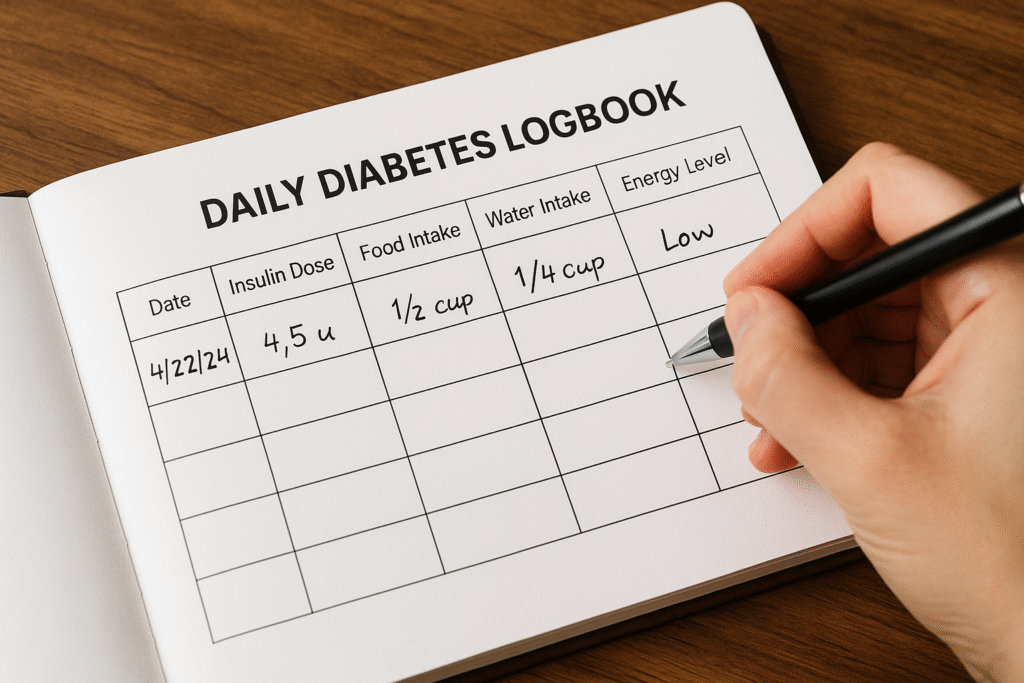
When it comes to successfully managing diabetes in dogs, consistency and observation are key. One of the most effective tools I recommend to my clients is a daily log. It doesn’t have to be complicated; a simple notebook or app can make a world of difference. These logs help detect trends, troubleshoot issues, and guide adjustments over time.
Here’s what you should track each day:
- Insulin Dose and Time: Record the exact amount and time of each injection. This is crucial for identifying whether blood sugar patterns match up with insulin activity.
- Meal Timing and Appetite: Note what your dog eats, how much, and whether they finish their meal. Missed or delayed meals can cause dangerous drops in blood sugar. Also, changes in appetite may indicate poor glucose control or other medical issues.
- Water Consumption: Increased thirst is one of the most common signs of poorly controlled diabetes in dogs. If your dog suddenly starts drinking more or less than usual, it could be a red flag.
- Signs of Hypoglycaemia: Watch for early warning signs like trembling, weakness, wobblyness, or acting confused. These signs often precede serious lows and need immediate attention.
- Urination Frequency: More frequent urination, especially accidents in the house, may suggest rising glucose levels and warrant a glucose curve or blood test.
These observations, when shared with your vet, provide invaluable insight. I’ve had cases where a subtle shift in water intake was the first clue something was off, long before a blood test confirmed it. Logging these details turns you into your dog’s best health advocate.
Best Diet Strategies for Diabetic Dogs
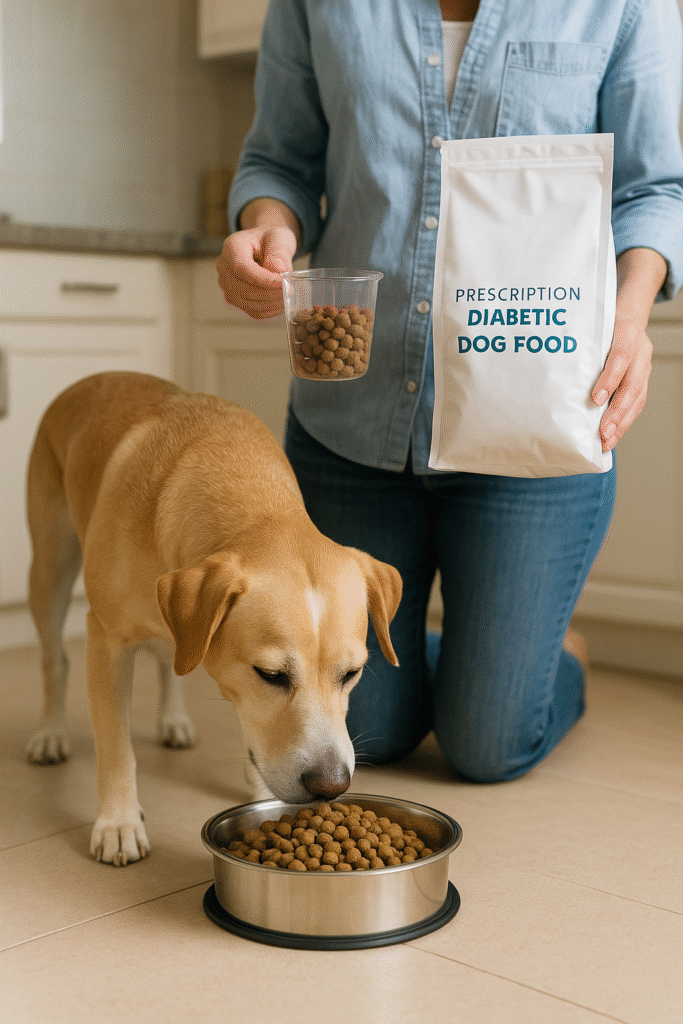
A consistent, tailored diet is just as crucial as insulin in managing diabetes in dogs. What and when your dog eats directly affects blood sugar levels. In my clinic, I often say: “Insulin is only half the treatment. Diet is the other half.”
Dietary Goals from AAHA
According to the AAHA diabetes guidelines, the ideal diabetic dog diet should:
- Maintain a lean body condition
- Provide adequate protein
- Include complex carbohydrates for slower glucose absorption
- Be low to moderate in fat (especially if pancreatitis is a risk)
- Deliver consistent calories, portions, and timing daily
Choosing the Right Food
There’s no one-size-fits-all food for diabetes in dogs, but options include:
1. Veterinary Prescription Diets
Examples: Hill’s w/d, Royal Canin Diabetic, Purina DM
- Fixed formula = consistent ingredients
- Higher in insoluble fibre
- Ideal for overweight or insulin-resistant dogs
2. Over-the-Counter Diets
- Work if meals are strictly portioned and contain predictable ingredients
- Choose formulas with moderate protein, complex carbs, and low-fat content
- Avoid semi-moist foods, which often contain added sugars or propylene glycol (PetMD)
In some cases, I’ve advised home-cooked diets using recipes formulated by veterinary nutritionists, especially for dogs with concurrent issues like food allergies or pancreatitis.
Timing Matters
Consistency is king when managing canine diabetes. Dogs should:
- Eat two evenly spaced meals per day
- Have meals aligned with insulin timing
Example: Feed 30 minutes before Vetsulin - Avoid treats between meals unless advised for hypoglycemia prevention
I recommend picking specific times (e.g., 7 AM and 7 PM) and sticking to that schedule every day, even on weekends.
Real-World Tip
If your dog is a picky eater, monitor their intake before injecting insulin. Giving insulin to a dog that skips their meal increases the risk of low blood sugar. I tell my clients: “No food, no insulin. Or at least give a reduced dose—call us if unsure.”
At-Home Care Tips from a Veterinarian
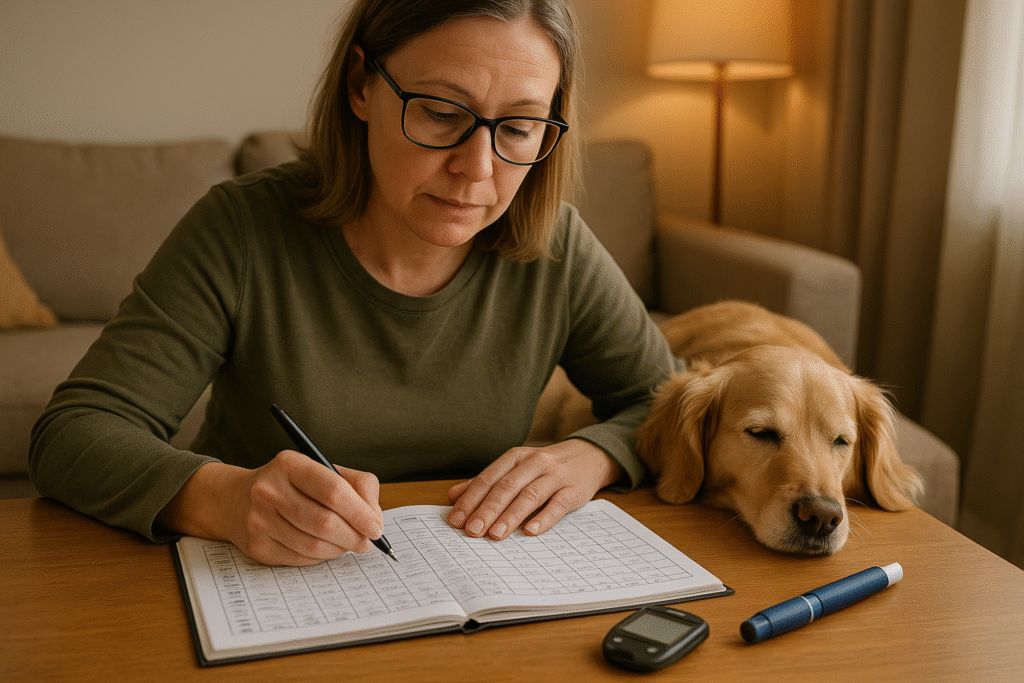
Managing diabetes in dogs at home doesn’t have to be overwhelming. With a few routines and tools, most owners quickly gain confidence. Some of the most successful diabetic dog cases I’ve managed are with owners who embraced daily logs and proactive monitoring.
5-Minute Daily Checklist
Each day, aim to track:
- Insulin dose and time (use alarms or calendar reminders)
- Meal amount and timing
- Water intake (excessive drinking may signal poor control)
- Appetite and bowel movements
- Energy levels and behaviour
I encourage pet parents to use a simple notebook or diabetes app to jot these down. These patterns help your vet adjust treatment over time.
Hypoglycaemia: Know the Signs
Even well-managed dogs can experience low blood sugar. Watch for:
- Shaking or trembling
- Weakness or wobbliness
- Disorientation or glazed look
- Seizures (in severe cases)
Mild signs? Rub corn syrup or honey on their gums and recheck in 15 minutes. Severe signs? Head to your vet or emergency clinic immediately (Vet Times).
Exercise: Keep It Predictable
Routine activity can help regulate glucose, but too much sudden exercise can drop blood sugar. Try:
- Daily 20–30 minute walks at the same time
- Avoid intense bursts (e.g., fetch marathons) without food adjustment
- Don’t skip meals on high-activity days
When to Call Your Vet
Reach out if:
- Your dog skips meals for >12 hours
- Vomiting or diarrhea occurs
- Blood glucose remains <4.0 mmol/L or >20 mmol/L
- Your dog seems “off,” and you can’t pinpoint why
I’d rather have a cautious owner call me too often than miss something serious.
Costs of Managing Canine Diabetes in Canada
Caring for a dog with diabetes involves both emotional and financial commitment. In Canada, monthly costs can vary based on the insulin type, frequency of veterinary visits, and whether you’re using home monitoring tools. Here’s a practical breakdown to help plan.
Typical Monthly Expenses
| Expense Category | Low Estimate (CAD) | High Estimate (CAD) |
|---|---|---|
| Insulin (Vetsulin, ProZinc) | $50 | $100 |
| Syringes / Pens | $10 | $30 |
| Glucose Monitoring Supplies | $25 | $80 |
| Diabetic Dog Food | $60 | $120 |
| Vet Visits / Blood Work | $40 | $150 |
| Total per Month | $185 | $480 |
Note: These are averages from my Ontario-based practice. Emergency visits or switching insulin types can increase costs temporarily.
Yearly Snapshot
Plan for $2,000–CAD 5,000 per year for routine diabetes management, not including emergencies. Some pet insurance plans partially cover diabetes-related care, but many have pre-existing condition exclusions.
Common Questions About Diabetes in Dogs
Pet owners managing diabetes in dogs often ask similar, urgent questions, especially in the first few months. Here are real-world answers based on both current guidelines and firsthand veterinary experience.
Can dogs go into remission like cats?
Unlike type 2 diabetes in cats, diabetes in dogs is typically type 1 and irreversible. That means dogs rarely go into remission. Insulin therapy is lifelong, though dosage may change with weight loss or improved control (AAHA).
What if my dog won’t eat before an insulin shot?
Don’t give the full insulin dose. Try offering a different meal, warming the food, or adding a small topper like boiled chicken. If your dog still refuses to eat, contact your vet. Giving insulin without food increases the risk of hypoglycaemia (Cornell).
How long can dogs live with diabetes?
With consistent care, many diabetic dogs live 2–5+ years after diagnosis, and some much longer. I have patients who’ve lived over 8 years post-diagnosis with good control and no serious complications.
Why does my dog’s blood sugar drop suddenly?
Common causes include:
- Too much insulin
- Delayed or missed meals
- Intense exercise without adjustment
- Other illnesses affecting insulin sensitivity
Always log events and check glucose if signs arise. Hypoglycaemia can be life-threatening if unrecognized.
Can I adjust the insulin dose on my own?
No. Even small changes can dramatically affect blood sugar. Always consult your vet before making adjustments. In my practice, we use home glucose readings or curves to guide changes safely.
Final Thoughts: Helping Your Dog Thrive
Living with diabetes in dogs may feel like a steep learning curve at first, but it becomes routine faster than most owners expect. With a stable insulin schedule, consistent meals, and simple monitoring tools, diabetic dogs can live joyful, comfortable lives.
As a veterinarian, I’ve seen firsthand how empowering it can be when owners take charge, tracking trends, asking questions, and learning what works for their dog. And when setbacks happen (they will), know that it’s part of the journey, not a failure.
Always keep open communication with your veterinary team, especially if:
- Blood glucose is consistently high or low
- Your dog’s appetite, weight, or behaviour changes
- You’re unsure about insulin timing or dose
With the right support, most dogs with diabetes enjoy full, active lives doing what they love: chasing squirrels, wagging for dinner, and curling up with their humans.

